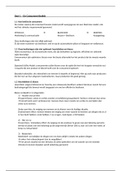Resume
Summary Cognitive Psychology II (English)
- Cours
- Cognitieve Psychologie 2
- Établissement
- Vrije Universiteit Brussel (VUB)
Samenvatting van alle colleges en gastcolleges van Cognitive Psychology II. Hoofddocent Prof. Braem. Slides en eigen notities staan erin verwerkt! Veel succes!
[Montrer plus]












